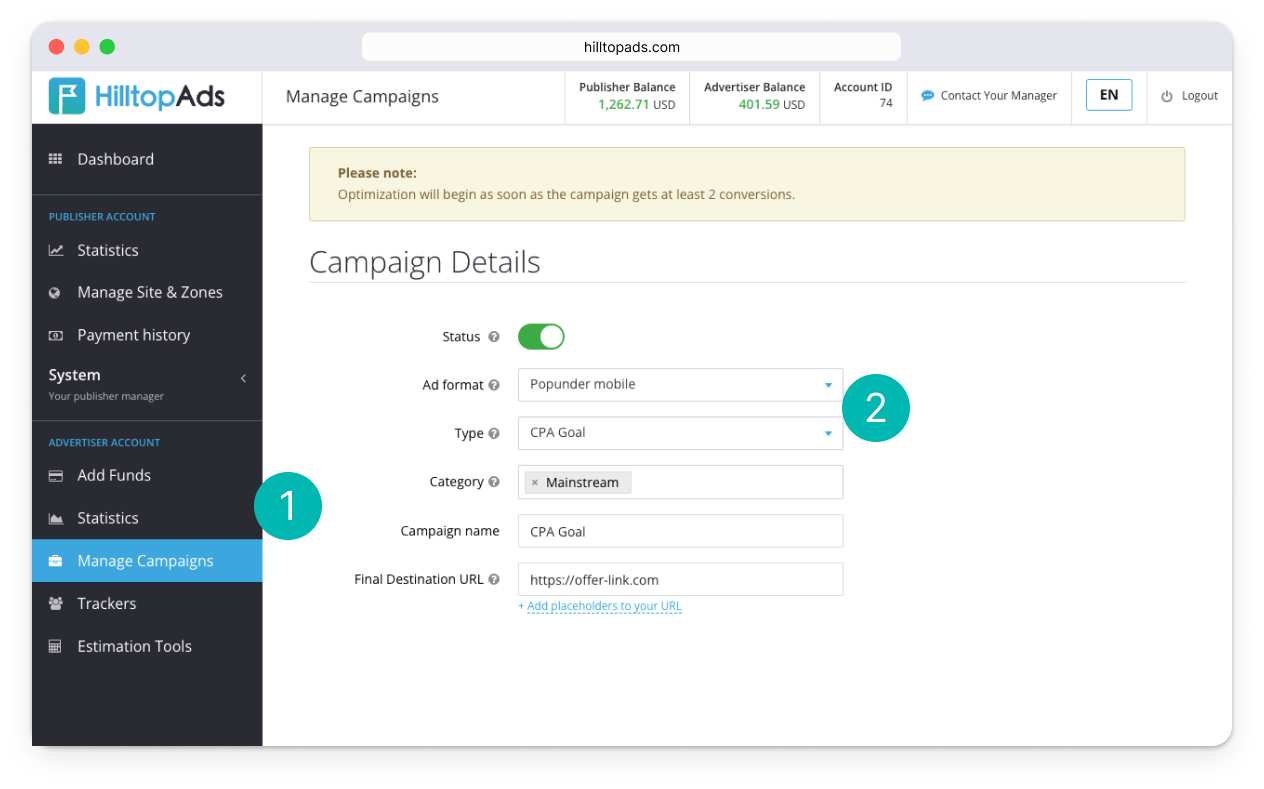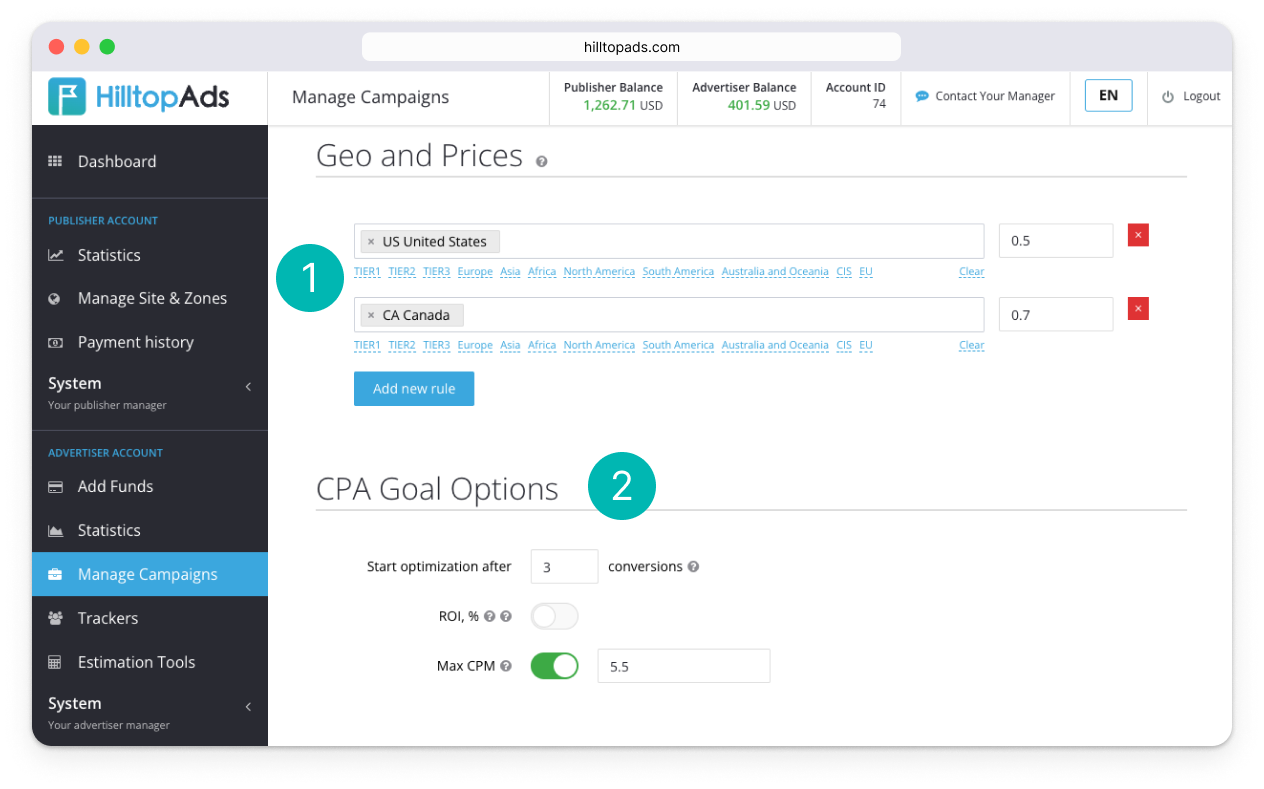At HilltopAds, there are a lot of helpful tools for advertisers to help them make high profit:
- Interests-based and keywords targeting.
- Automatic Optimization.
- Traffic segmentation…
And today we are ready to announce our new incredible feature that will change your advertising experience: CPA Goal. In this article, we will look at the CPA Goal meaning, its advantages and drawbacks, as well as the setup process. Moreover, we will share with you some tips to make your first tests with CPA Goal much easier and more profitable. Let’s go!
What is CPA Goal?
Firstly, we need to dive deeper into discussing about CPA Goal background.CPA (cost-per-acquisition) is a pricing model when advertisers pay for each conversion only.
CPA = spent / number of conversions.
For example, if advertisers’ cost is about $100 and they get 20 conversions, so: CPA = 100 / 20 = $5.
Thanks to understanding of conversion cost, advertisers can optimize their expenses on traffic sources and evaluate its effectiveness. But advertisers need to do that manually and on time to not to lose their advertising budget.By the way, at HilltopAds advertisers can buy traffic by CPM (for each 1,000 impressions), CPA (for each conversion) or CPC (for each click).
So, that is why the super man of affiliate marketing is becoming a CPA Goal model. CPA Goal is an optimization tool that helps advertisers, whose main advertising KPI is conversions, automatically delete from their campaigns non-performing traffic zones based on set conversion cost.
CPA Goal advantages and drawbacks:
CPA Goal has the main benefits such as:- Automatically ad campaign optimization;
- Safety from extra spendings;
- Easy and flexible configuration.
- Postback is need to be set up for correctly work of CPA Goal;
- Some time is needed for test periods;
- We recommend running CPA Goal campaigns for tests only.
How does CPA Goal work?
For now, let’s see how the CPA Goal tool works. Firstly, advertisers need to specify their rules based on that advertising systems will automatically optimize traffic sources. For example, number of conversions, cost per one conversion, cost per one conversion in the exact country, max CPM, etc.After your CPA Goal campaign is active, advertising systems will check each traffic zone for compliance with your rules. If it is noticed that some zone does not comply with your rule (for example, in zone X the cost of conversions will be higher than you need), then the system itself will disable this zone from the list of active traffic sources.
How to set up CPA Goal ad campaigns at HilltopAds?
Ok, and know we are ready to tell you more about setting up CPA Goal campaigns at HilltopAds. Firstly, you need to register with HilltopAds as an Advertiser. Then you need to navigate to the Manage Campaign section and click the Add campaign button.Here we need to pay your attention that the CPA Goal is available only for Popunder ad format (both desktop and mobile). So, from the ad format list select Popunder. In the Type field select the CPA Goal option.

We will not focus in detail on the process of creating a campaign, targeting settings, because we already have detailed guides in our Help Center. Therefore, we immediately proceed to setting up the rules of the CPA Goal.
HilltopAds CPA Goal settings
There are two sections that you need to work with.In the GEO and Prices section you need to specify the cost per one conversion in targeted GEO in USD.
For example, you are a media buyer who works with a CPA offer. So, when you select an offer, in its description you need to check available country (GEO) and rate. Let's imagine that we have selected a VPN offer that needs to be promoted in the US and the rate is $0.5
In HilltopAds, we need to specify the United States in the Countries field, and 0.5 in the field next to it.
If there are several countries, you can add a new rule. You can create up to 100 rules (rules will be connected with the AND logic).
The last but not least is the CPA Goal Options section. There you need to:
- Specify the Start optimization option. By default, optimization starts after 2 conversions received. So you can specify the required number of conversions.
- ROI (return on investment). The HilltopAds system will automatically count ROI per campaign. For example, you want your ROI to be about 30%. So, the system will calculate it and keep your expenses and profit within the specified ROI. This feature is available upon request to your personal manager.
- Max CPM - there you need to specify the maximum CPM rate that should be kept within the specified rate. You can set up this rule to not to spend all your money on one traffic zone that converts incredibly.

After all settings are done, do not forget to click the Add campaign button to save your settings.
If you have not worked with HilltopAds yet, it is the perfect time to start! Apply a promo code CPAGOAL and get +20% to your first deposit of at least $100.
Register with HilltopAds, Create your CPA GOAL campaign, and Boost the effectiveness of your Ads!







